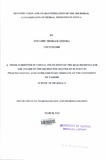| dc.description.abstract | With the ever increasing use of herbal medicines and the global expansion of the herbal
medicines market, safety has become a concern for both health authorities and the public in
many countries. This is because many contaminants and residues that may cause harm to the
consumers have been reported. Many are natural such as naturally occurring radioxides, toxic
metals, bacteria and fungi. Some arise from past and present use of agents or materials that
pollute the environment and subsequently medicinal plants, such as emissions from factories or
the residues of certain pesticides. Microbial contamination of herbal medicines can be influenced
by environmental factors such as temperature, humidity and extent of rainfall during preharvesting
and post-harvesting periods, handling practices and the storage conditions of crude
and processed medicinal-plant materials. For these reasons, there is currently a global danger to
the health and well-being of the people. The World Health Organization, British Pharmacopoeia
and the United States Pharmacopoeia have recommended tolerable microbial limits in non-sterile
pharmaceutical products which include 107 cfulml bacteria and 105 cfulml fungi. These risks can
be reduced by ensuring that there is enough surveillance of herbal medicines so that those with
harmful contaminants and residues above recommended limits do not reach the public. This
study therefore was aimed at identification and characterization of the microbial contaminants in
herbal medicines sold in Kenyan herbal clinics, Chemists, supermarkets and streets. The
microbial loads were established and the contaminants isolated and identified.
Thirty (30) herbal products collected by purposive random sampling were analyzed for their
microbial contaminants. Microbial load analysis was done and interpreted based on the methods
recorded by the USP and BP while isolation of pure cultures was done based on morphological
differences where form, elevation, pigmentation and size were the major distinguishing factors
for both fungal and bacterial contaminants. The pure isolates were then stocked in glycerol and
stored in a freezer at -23°C from where they were used for subsequent identifications. Gramstaining
procedure was used to classify bacteria into Gram-negative and Gram-positive while
microscopic and macroscopic observations formed the basis for fungal identification. Specific
microbes were then characterized using differential and selective media and later confirmed
using API 20 E strip following procedures by the manufacturer. Molecular characterization of
the microbes that were not identified using the above techniques was done using the QiaAmp
procedures for DNA extraction, agarose gel analysis and cleaning of the peR products.
Sequencing was then done in Segolip (Ilri).
Fourteen (47 %) of the analyzed samples were powders, nine (30 %) liquids, five (16 %) tablets,
onebalm and capsule each (3 %). Blood purifiers, food supplements and antidiabetics formed the
majority of herbal products in the market (50 %) while the rest claimed to manage blood
pressure, STD and GIT problems among others. Ten (33 %) of the samples had a colony count of
below 30 cfulml, these were interpreted as free from contamination. Twenty (67 %) of the
sampleshowever had bacterial counts in the range of6.00 x 105 to 1.56 x 1010 cful ml and fungal
count in the range of 5.30 x 104 to 1.56 x 109 cful ml. Of the 19 different types of bacteria
identified, 13 (68 %) were Gram-negative rods while 6 (32 %) were Gram-positive rods and
COCCI.
The tests for specified microorganisms using differential and selective media confirmed the
presence of Staphylococcus aureus, Klebsiella pneumonia, Escherichia coli, Shigella and
Candida spp. in abundant growths. Microscopic and macroscopic examinations confirmed the
presence of fungi i.e. Rhizopus, Candida, Fusarium, Aspergillus, Torula, Penicillium and
Alternaria also in abundance. Biochemical tests by API 20 E confirmed the presence of
Enterobacter agglomerurans, Serratia marsensens, Klebsiella oxytocca, Chryseomonus luteola,
Flavobacterium spp and Enterobacter cloacae. Further genotypic analyzes of the isolates that
were not identified and characterized by morphological and biochemical methods revealed the
presence of Kocuria rosea, Bacillus pumilus, Cronobacter sakazakii, Bacillus safensis, Bacillus
subtilis and Bacillus flex us some of the microbes isolated and characterized are pathogenic
especially to immune-compromised individuals.
From this study, it is evident that herbal medicines sold in Kenya without control or regulations
are contaminated with microbes which are potential pathogens hence pose a threat to patients. It
is therefore recommended that a policy be established to enable regulation of these products.
Herbalists should be trained to apply Good Manufacturing Practices, good harvesting practices
and the safe handling and storage of herbal medicinal products. Further studies are recommended
for herbal products to establish other contaminants and ways in which the contaminants can be
reduced to recommended levels. | en_US |
| dc.description.department | a
Department of Psychiatry, University of Nairobi, ; bDepartment of Mental Health, School of Medicine,
Moi University, Eldoret, Kenya | |

